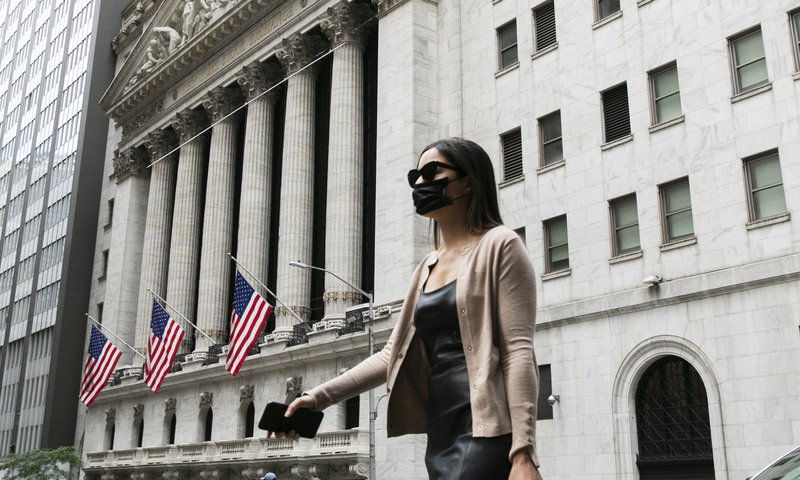Stocks were down badly today as U.S. daily coronavirus cases hit record highs and investors dealt with the likelihood that stimulus negotiations will not produce a bipartisan relief deal before Election Day.
The Dow Jones Industrial Average had lost more than 880 points shortly before 1:30 p.m., falling 3.1 percent after more than 83,000 new U.S. cases of COVID-19 were confirmed Saturday, shattering previous records.
The S&P 500 index had fallen 2.6 percent, and the Nasdaq composite fell 2.5 percent with less than three hours before markets closed.
Today’s losses come amid increasing concern that the U.S will suffer under a punishing, nationwide surge in coronavirus cases with no further help from the federal government until after the elections.
The rise in COVID-19 cases has sparked fears that the U.S. will need to reimpose restrictions and business closures that had been previously lifted, following in the footsteps of European countries who have done the same.
“Monday starts on a bleak note due to worries about rising virus caseloads. It was an ugly weekend from a COVID-19 standpoint, and we’re seeing Wall Street react with stock futures stumbling and volatility charging back up,” wrote JJ Kinahan, chief market strategist at TD Ameritrade, in a research note published before the market opened.
“Some U.S. states and European countries are bringing back shutdowns, and that’s hurting some of the ‘reopening’ stocks like cruise lines, restaurants, and airlines.”
The U.S. is on track to face that resurgence without the boost from a bipartisan coronavirus relief bill barring a stunning breakthrough in talks between Speaker Nancy Pelosi (D-Calif.) and Treasury Secretary Steven Mnuchin.
The top Democratic and Republican negotiators reported slow but steady progress over nearly three weeks of negotiations intended to cement a bipartisan deal before Election Day.
But the talks have devolved into finger-pointing and appear to be unlikely to produce a deal with less than two weeks until Nov. 3.
“Covid, Covid. Covid, Covid, Covid, Covid,” President Trump groused at a rally in North Carolina on Saturday, expressing dismay that the deadly coronavirus pandemic had come to dominate the final days of his struggling re-election campaign.
He made up a scenario: “A plane goes down, 500 people dead, they don’t talk about it. ‘Covid, Covid, Covid, Covid.’”
But just seven hours later, the White House made its own Covid headlines when officials acknowledged that another coronavirus outbreak had struck the White House, infecting Vice President Mike Pence’s chief of staff and four other top aides — and raising new questions about the Trump administration’s cavalier approach to the worst health crisis in a century.
“We’re not going to control the pandemic,” Mark Meadows, the White House chief of staff, said on CNN’s “State of the Union” on Sunday morning, essentially offering a verbal shrug in response to any effort to prevent an outbreak in the top echelon of the nation’s leaders. “We are going to control the fact that we get vaccines, therapeutics and other mitigations, because it is a contagious virus — just like the flu.”
Joe Biden said Sunday that the statement by Meadows was “an acknowledgment of what President Trump’s strategy has clearly been from the beginning of this crisis: to wave the white flag of defeat and hope that by ignoring it, the virus would simply go away. It hasn’t, and it won’t.”
“It’s sadly no surprise then that this virus continues to rage unchecked across the country and even in the White House itself,” said the former vice president, who has sought to make the administration’s handling of the coronavirus the centerpiece of his campaign.
From the beginning, Trump has downplayed the threat of the virus, initially insisting that it would just “go away” and failing to ramp up testing that might have helped slow its spread.
Trump clashed with his own scientists, pressuring officials at the Centers for Disease Control and Prevention to change their restrictive recommendations about how and when to reopen businesses and schools.
The president organized his pandemic response around his political ideology, warring with “blue state” governors while praising the hands-off approach of Republican leaders.
And he publicly sided with people frustrated with restrictions and shutdowns, demanding on Twitter that the governor of Michigan, among others, “liberate” her state.
Trump turned mask wearing and other preventive measures into political loyalty tests, dismissing the critical importance of social distancing and pinning his hopes on Operation Warp Speed, a plan to accelerate development and distribution of a vaccine that has shown promise, but that scientists have insisted was never going to be quick or easy.
The president and his aides have taken the same approach inside the White House.
They have declined to follow quarantine guidelines, ignored warnings from doctors, largely refused to wear masks and, in the case of the president, mocked reporters who did as recently as Friday in the Oval Office.
The only person in the president’s orbit whose own experience with the virus appeared to have altered his thinking is Chris Christie, the former New Jersey governor, who was hospitalized after testing positive and now urges Americans to wear masks and practice social distancing.
“These minor inconveniences can save your life, your neighbors and the economy,” he wrote last week in an op-ed in The Wall Street Journal. “Seldom has so little been asked for so much benefit. Yet the message will be broadly heeded only if it is consistently and honestly delivered by the media, religious leaders, sports figures and public servants.
“Those in positions of authority,” he said — without directly mentioning Trump and Pence — “have a duty to get the message out.”
